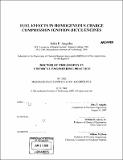Fuel effects in homogeneous charge compression ignition (HCCI) engines
Author(s)
Angelos, John P. (John Phillip)
DownloadFull printable version (30.12Mb)
Other Contributors
Massachusetts Institute of Technology. Dept. of Chemical Engineering.
Advisor
William H. Green, Jr.
Terms of use
Metadata
Show full item recordAbstract
Homogenous-charge, compression-ignition (HCCI) combustion is a new method of burning fuel in internal combustion (IC) engines. In an HCCI engine, the fuel and air are premixed prior to combustion, like in a spark-ignition (SI) engine. However, rather than using a spark to initiate combustion, the mixture is ignited through compression only, as in a compression-ignition (CI) engine; this makes combustion in HCCI engines much more sensitive to fuel chemistry than in traditional IC engines. The union of SI- and CI-technologies gives HCCI engines substantial efficiency and emissions advantages. However, one major challenge preventing significant commercialization of HCCI technology is its small operating range compared to traditional IC engines. This project examined the effects of fuel chemistry on the size of the HCCI operating region, with an emphasis on the low-load limit (LLL) of HCCI operability. If commercialized, HCCI engines will have to operate using standard commercial fuels. Therefore investigating the impact of fuel chemistry variations in commercial gasolines on the HCCI operability limits is critical to determining the fate of HCCI commercialization. To examine these effects, the operating ranges of 12 gasolines were mapped in a naturally-aspirated, single-cylinder HCCI engine, which used negative valve overlap to induce HCCI combustion. The fuels were blended from commercial refinery streams to span the range of market-typical variability in aromatic, ethanol, and olefin concentrations, RON, and volatility. The results indicated that all fuels achieved nearly equal operating ranges. The LLL of HCCI operability was completely insensitive to fuel chemistry, within experimental measurement error. The high-load limit showed minor fuel effects, but the trends in fuel performance were not consistent across all the speeds studied. These results suggest that fuel sensitivity is not an obstacle to auto-makers and/or fuel companies to introducing HCCI technology. (cont.) Developing an understanding of what causes an HCCI engine to misfire allows for estimation of how fuel chemistry and engine operating conditions affect the LLL. The underlying physics of a misfire were studied with an HCCI simulation tool (MITES), which used detailed chemical kinetics to model the combustion process. MITES was used to establish the minimum ignition temperature (Tmisfire) and full-cycle, steady-state temperature (Tss) for a fuel as a function of residual fraction. Comparison of Tmisfire and Tss near the misfire limit showed that Tss approaches Tmisfire quite closely (to within ~ 14 K), suggesting that the primary cause of a misfire is insufficient thermal energy needed to sustain combustion for multiple cycles. With this relationship, the effects of engine speed and fuel chemistry on the LLL were examined. Reducing the engine speed caused a reduction in T, which allowed fuel chemistry effects to be more apparent. This effect was also observed experimentally with 2 primary reference fuels (PRFs): PRF60 and PRF90. At 1000 RPM, PRF60 obtained a substantially lower (~30%) LLL than PRF90, but at speeds >/= 1500 RPM, fuel ignitability had no effect on the LLL. Fuel chemistry was shown to influence the LLL by increasing both Tmisfire and Tss for more auto-ignition resistant fuels. However, the extent to which fuel chemistry affects these temperatures may not be equivalent. Therefore, the relative movement of each temperature determines the extent to which fuel chemistry impacts the LLL.
Description
Thesis (Ph. D.)--Massachusetts Institute of Technology, Dept. of Chemical Engineering, 2009. Includes bibliographical references (p. 209-217).
Date issued
2009Department
Massachusetts Institute of Technology. Department of Chemical EngineeringPublisher
Massachusetts Institute of Technology
Keywords
Chemical Engineering.